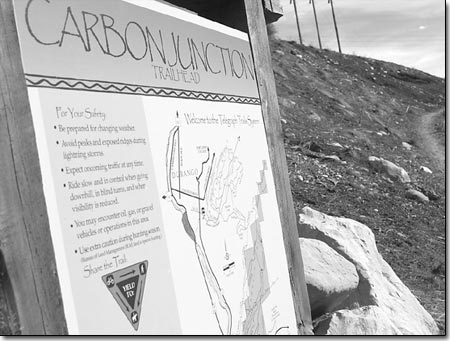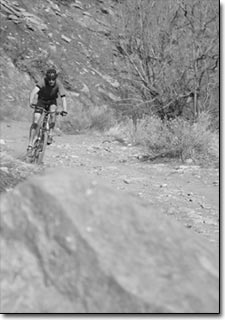|
Trails 2000 works to blend singletrack and growth
by Missy Votel
 |
| A sign marks the Carbon Junction
trailhead off Highway 3, south of Durango. Trails 2000 is
working to ensure that Carbon Junction, as well as the other
trails within the Horse Gulch-Telegraph system, are preserved
in the face of encroaching development./Photo by Todd Newcomer. |
With growth on the horizon, Trails 2000, Durango’s trails
advocacy group, is working to ensure that new trails are incorporated
into developments and existing trails do not fall prey to expansion.
Of particular concern is the popular Telegraph trail system,
immediately south and east of town. More than 30 miles of trails
make up the network, which lies on a mix of public and private
land. However, adjacent land is slated for everything from homes
and golf courses to a new hospital and city reservoir, all of
which could potentially alter the trails and the surrounding landscape.
Perhaps the most high profile area of development is Grandview,
southeast of the trail system. The area will become home to the
Southern Ute Tribe’s Three Springs subdivision, 2,200 homes
on 682 acres; and the new Mercy Medical Center campus, on 35 acres,
among other things.
Bill Manning, executive director of Trails 2000, said the group
has worked to ensure that the new homes will have access to the
Telegraph system, and ultimately, Durango.
“We worked very hard with developers and the city to get
trail access points and trails integrated,” said Manning.
“We worked hard for the neighborhoods to have access to
trails and the BLM area referred to as Grandview Ridge, the Cowboy
Trail and South Rim Trail.”
Plans also call for a trail around the new hospital.
“We’ve gotten Mercy to agree to a little loop trail,
a walking path for patients, visitors and staff to get a breath
of fresh air,” he said.
In addition to this, Manning said the group is working in tandem
with several other entities on the Smart 160 Trail, which ultimately
will connect Durango and Bayfield.
“It will be an urban style path similar to the Animas River
Trail,” he said.
The trail is still in the conceptual stage, with most of the
effort being focused on connecting the Animas River Trail to Grandview.
“We’re focusing on the first couple of miles,”
he said.
The trail will generally parallel Highway 160, and right now
various alignments are being explored by a consortium made up
of the City of Durango, La Plata County, the Colorado Department
of Transportation and utility companies. One solution would use
utility lines as the basis for the trail. Once the trenches are
dug and the lines buried, the trail would be placed on top.
“That’s done all over the U.S.,” said Manning.
“Those utility connections work well for a trail as well.”
While all this may bode well for trail users, there remains one
unknown which could have a profound effect on the Grandview Ridge
trails. In order to alleviate traffic on an already congested
Highway 160, the idea of a new bypass that would connect Durango
to Grandview, possibly via Highway 3, is being explored. Although
an exact alignment has not been determined, the road would cross
Bureau of Land Management land that is home to several trails.
 |
| A biker descends Horse Gulch
Road on Monday. Much of the land surrounding the county road
is private property and the idea of developing it has been
talked about for years although nothing formal has been done./Photo
by Todd Newcomer. |
Manning said he has only seen rough, conceptual drawings of where
the road would go, but judging by the area’s topography,
there really are only a few options.
“Where is the road likely to go? There’s probably
about three choices,” he said. “I would guess it’ll
affect Carbon Junction, maybe Sidewinder. It would affect Grandview
Ridge and Cowboy.”
However, Manning maintains that the trails will not be a total
loss.
“We want to make sure that trails are accommodated in any
new road development,” he said. “I hope we can get
some safe crossings and maybe some underpasses in the event the
road becomes real.”
He said that the fact that the road would cross BLM land could
actually help preserve the trails.
“The BLM is big on the concept of multi use,” he
said.
Manning also said the negotiations over rerouting the Carbon
Junction Trail are ongoing. Durango Gravel is looking to expand
operations and mine the area at the top end of the trail. Trails
2000, La Plata County and Oakridge Energy, the company that owns
much of the land 4 in Horse Gulch and the lease to Durango Gravel,
have been looking for a solution for more than a year. The Carbon
Junction trail hooks in with Crite’s Connect and Sidewinder
at its north end and dumps out at the south end of Highway 3.
Manning said there are discussions to move the top of the trail
in a canyon to the east.
“We thought we’d do it last summer,” he said.
“But, until all parties get their acts together, we won’t
be doing anything. Stay tuned.”
Over Grandview Ridge and to the northwest is the Horse Gulch
part of the trail system, which sits mostly on private property
once owned by Noel Pautsky. Manning said Pautsky permanently deeded
ownership of the Horse Gulch trails to the county when he passed
away. However, the Pautsky family, which still owns the land as
well as Oakridge Energy, has the right to relocate the trails.
“The trail surface, 12 feet wide, is actually owned by
the county,” said Manning. “Beyond that, the corridor
is owned by the Oakridge Energy company.”
Pautsky’s daughter, Sandra Pautsky, has proposed a major
development on Ewing Mesa, 1,495 acres of land adjacent to Highway
3. A conceptual plan for the development, called Oakridge, calls
for up to 1,700 homes as well as a 27-hole golf course and resort,
schools, and businesses on 1,110 acres.
“The land south of the (Horse Gulch) meadow is owned by
Oakridge Energy, which has been talking for years about a large-scale
development with one or more golf courses,” said Manning.
Although nothing formal on the Oakridge development has been
submitted to the city, in January, Durango City Council adopted
the Ewing Mesa Area Plan, which calls for up to 3,000 homes in
the area.
City Planner Greg Hoch said initial conceptual plans for the
Oakridge development showed “spill over” into the
lower reaches of Horse Gulch that could lead to one or two trails
being rerouted. However, he said the plan indicates how and where
these trails would be relocated.
“Basically, it’s just a shift in the location,”
he said.
Manning said if and when the Oakridge project goes through, the
effects would likely be a mixed bag.
“If you asked me if the trails would be affected by Ewing
Mesa, I would say ‘yes’ and ‘no,’”
he said. “‘Yes,’ because there will be more
people on the trails. ‘No’ because most of what we
we’ve acquired was given to the public by Noel Pautsky.
We carefully aligned the trails where they could be permanent.”
Another potential development that could affect the meadow trails
is a future city reservoir, which would go in the natural basin
that acts as the starting off point for several trails.
“The city bought the land in the event they needed to build
a reservoir,” said Manning. Whether the land is ever used
for such a purpose depends largely on whether the city buys into
the Animas-La Plata Project.
“Our position is we’re waiting to see,” said
Hoch
The land also is a former dump site, which would require extensive
clean up before a reservoir could go in, Manning said. Nevertheless,
he was confident the city and Trails 2000 could reach an agreement
should the reservoir ever be built.
“We have a loose agreement in place to route trails around
the reservoir,” he said.
Another potential player in the future of the Horse Gulch Trail
System is Fort Lewis College, which owns land north of County
Road 237, or Horse Gulch Road, in the Raider Ridge vicinity.
“FLC owns a lot of land up there,” said Manning.
However, Dave Eppich, assistant to the president for external
affairs, said he is aware of no plan to do anything with the land.
“In terms of development, I don’t think there’s
been any plan to develop that property,” he said.
Regardless of what the future holds, Manning said he was confident
that Trails 2000, with the strong support of the community, would
continue to work to protect one of its most important assets.
“I sure hope our community can rally and save the portions
of Horse Gulch and keep it undeveloped,” he said. “Whenever
I go up there, I see people happy as can be that they have a place
to be. It’s kind of heart warming.”
|

